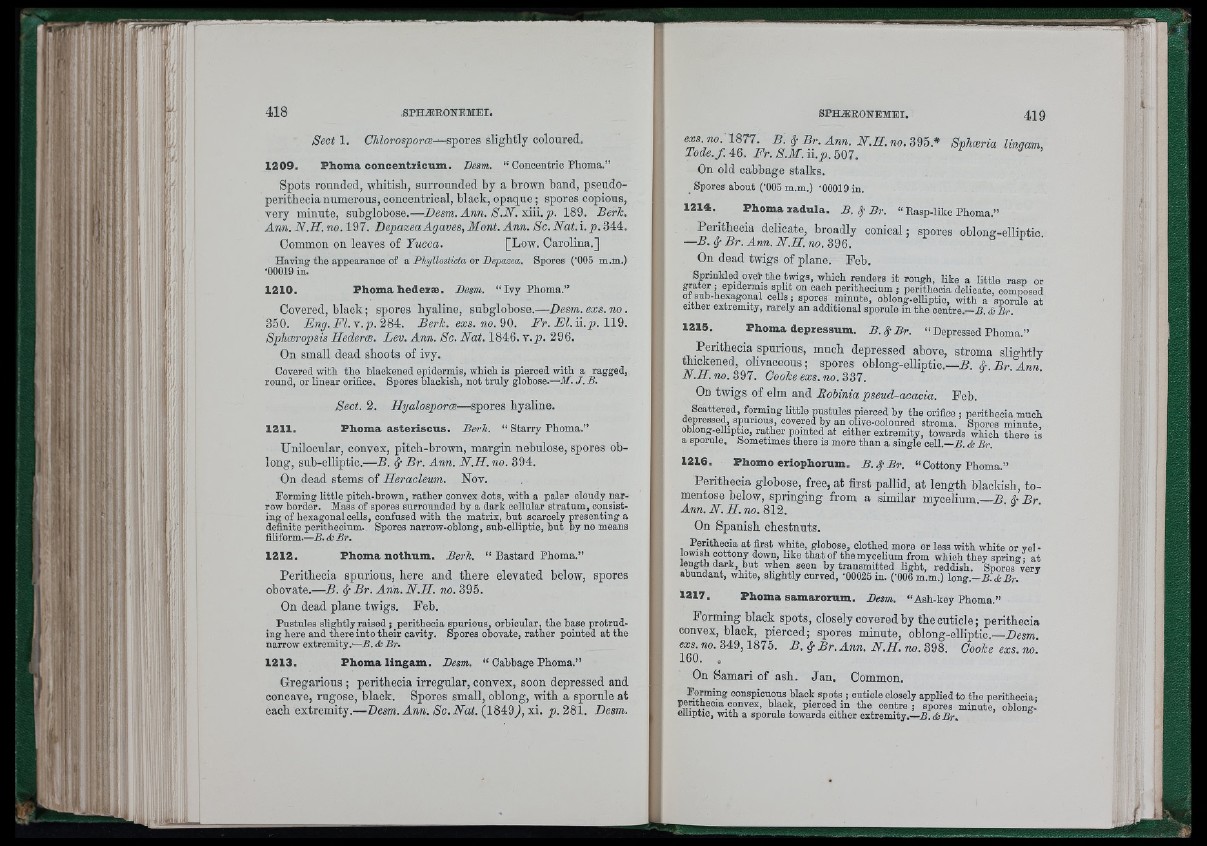
J
Sect 1. ChlorosporcBS-gcrQB sligbtly coloured.
1209. Phoma c o n c en tz icum . Desm. “ Concentric Phoma.”
Spots rounded, wbitisb, surrounded by a brown band, pseudo-
peritbecia numerous, concentrioal, black, opaque; spores copious,
very minute, subglobose.—Desm. Ann. S .N .'s iii.p . 189. Berh.
Ann. N .H . no. 197. DepazeaAgaves, Mont. Ann. S c .N a t.i.p .3 4 4 .
Common on leaves of Yucca. [Low. Carolina.]
Having the appearance of a Phijllostwta or Depazea. Sporea ("005 m.m.)
•00019 in.
1210. P hom a hedezse. Desm. “ Ivy Phoma.”
Covered, black; spores byaline, subglobose.—Desm. exs. no .
350. Eng. F l.r . p . 284. Berh. exs. no. 90. Fr. E l . i i . p . 119.
Spliceropsis Hederce. Lev. Ann. Sc. N at. 1846. r .p . 296.
On small dead sboots of ivy.
Covered with the blackened epidermis, which ia pierced with
round, or linear orifice. Spores blackish, not truly globose.—M. J . B.
Sect. 2. Hyalosporce—spores byaline.
1211. P hom a a s te z is c u s . Berk. “ Starry Phoma.”
Unilocular, convex, pitcb-brown, margin nebulose, spores oblong,
snb-elliptic.—B. / Br. Ann. N .H . no. 394.
On dead stems of Heracleum. Nov.
Forming little pitch-brown, rather convex dots, with a paler cloudy narrow
border. Mass of spores surrounded by a dark cellular stratum, consisting
of hexagonal cells, confused with the matrix, but scarcely presenting a
definite perithecium. Spores narrow-oblong, sub-elliptic, but by no means
filiform.—B.&Bt.
1212. Phoma n o th um . BerK “ Bastard Phoma.”
Peritbeoia spurious, bere and tbere elevated below, spores
obovate.—B. / Br. Ann. N .H . no. 395.
On dead plane twigs. Feb.
Pustules slightly raised ; peritheoia spurious, orbicular, the base protruding
here and there into their cavity. Spores obovate, rather pointed at the
narrow extremity.—B. & Br*
1213. P hom a lin g am . Bern* “ Cabbage Phoma.”
Gregarious ; peritbeoia irregular, convex, soon depressed and
concave, rugose, black. Spores small, oblong, witb a gporule at
eacb extremity.—Desm. Ann. Sc. Nat. (1 8 4 9 / xi. p. 281. Desm.
exs. no. 1877. B. / Br. Ann. N .H . no. 395.* 'ia lingam.
Tode.f. 46. Fr. S.M. ii.p. 507.
On old cabbage stalks.
_ Spores about ('005 m.m.) -OOOlfi in.
1214. Phoma zadula. B . 4 Dr. “ Easp-like Phoma.”
Perithecia delicate, broadly conical: spores oblong-elliptic
—B. 4 Br.An n . N .H . no.396.
On dead twigs of plane. Feb.
Sprinkled ovei-the twigs, which renders it rough, like a little rasp or
grater ; epidermis split on each perithecium ; peritheoia delicate, composed
of rab-hexagonal cells; spores minute, oblong-elUptic, with a sporule at
either extremity, rarely an additional sporule in the o e n tr e .—B .A B r .
1215. Phoma depzessum. B .4 B r . “ Depressed Phoma.”
Perithecia spurious, much depressed above, stroma slightly
thickened, olivaceous; spores oblong-elliptio.—N. 4. B r.A n n .
N .H. no. 397. Coohe exs. no. 337.
On twigs of elm and RoUnia pseud-acacia. Feb.
Scattered, forming little pustules pierced by the orifice ; perithecia much
depressed, spurious, covered by an olive-ooloured stroma. Spores minute,
oblong-elliptic, rather pointed at either extremity, towards which there is
a sporule. Sometimes there is more than a single cell.—B, A Br.
1216. Phomo eziophozum. B .4 B r . “ Cottony Phoma.”
Perithecia globose, free, at first pallid, at length blackish, tomentose
below, springing from a similar mycelium.—B & B r
A n n .N .H .n o . 812.
On Spanish chestnuts.
Pentheoia at first white, globose, clothed more or less with white or yellowish
cottony down, hke th at of the mycelium from which they spring- at
length dark, but when seen by transmitted light, reddish. Spores very
abundant, white, slightly curved, '00025 in. ('006 m.m.) lo n g .—B .ABr.
1217. Phoma samazozum. Besm. “Ash-key Phoma.”
Forming black spots, closely covered by tbe cuticle; perithecia
convex, black, pierced; spores minute, oblong-elliptic.—
exs. no. 349,1875. B. 4 B r. Ann. N .H . no. 398. Coohe exs. no.
160.
On Samari of asb. Jan. Common.
Forming conspicuous black spots ; cuticle closely applied to the perithecia-
penthecia convex, black, pierced iu the centre ; spores minute, oblong-’
elhptio, with a sporule towards either extremity.—A. A Br.
.iiu i